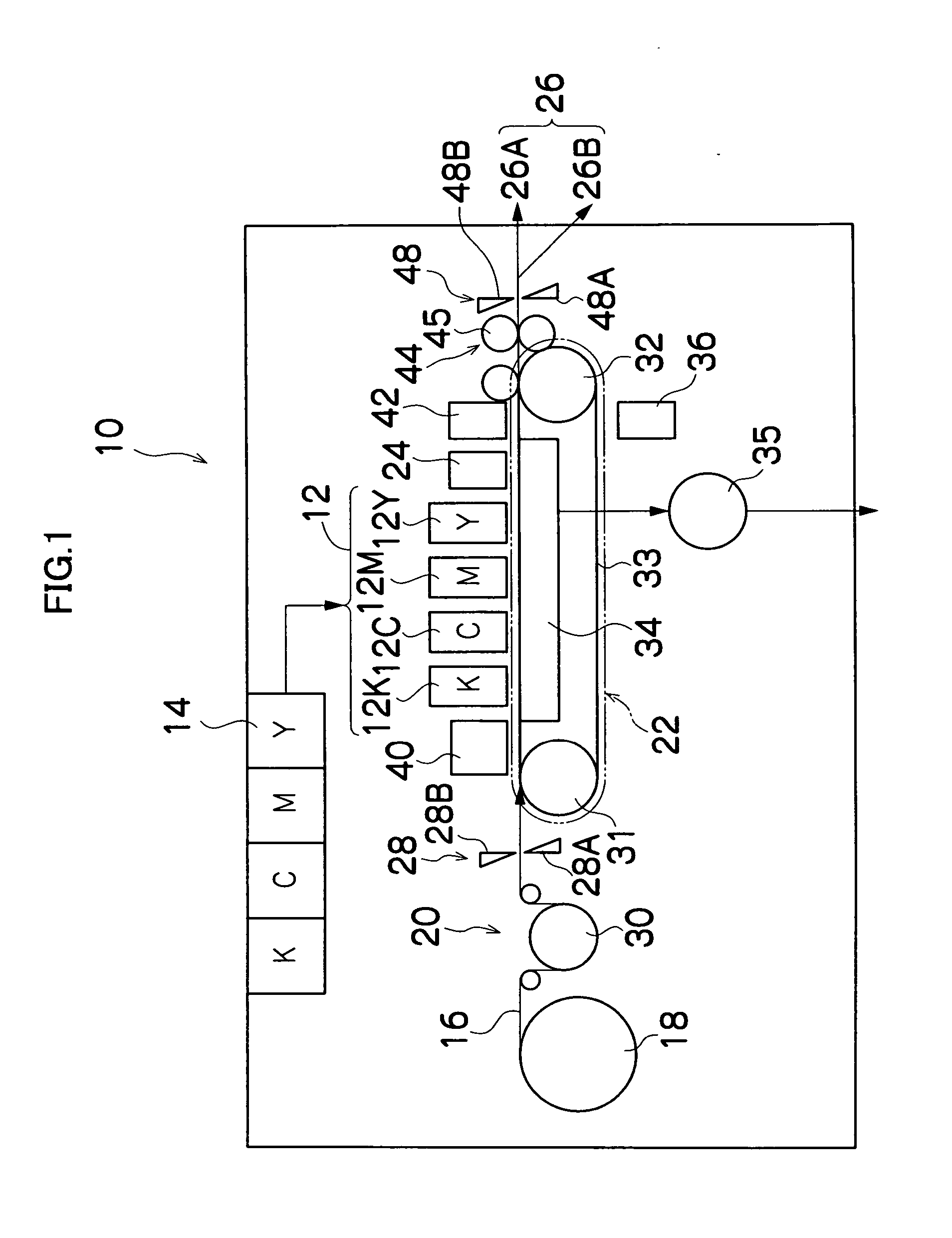Image forming apparatus and droplet ejection control method
a technology of droplet ejection and forming apparatus, which is applied in the direction of measuring apparatus components, instruments, and inks, can solve the problems of pigment not easily formed uniformly or pulverized, water resistance and light resistance drawbacks, and difficult to form images with high saturation, etc., to achieve high resolution, prevent image distortion, and increase recording time
- Summary
- Abstract
- Description
- Claims
- Application Information
AI Technical Summary
Benefits of technology
Problems solved by technology
Method used
Image
Examples
example 2
[0287] At room temperature, 0.15 g of 2,9-dimethylquinacridone was dissolved into 13.35 mL of dimethylsulfoxide, 1.65 mL of a 0.8 mol / L aqueous potassium hydroxide solution, and 0.75 g of polyvinyl pyrrolidone (K30, manufactured by Wako Pure Chemicals Industries, Ltd.). The resultant solution is designated to IB solution. The pH of the IB solution was over a measurable limit, and was unable to be measured. This IB solution and the IIA solution prepared in Example 1 were separately passed through a micro-filter having pores of 0.45 μm diameter (manufactured by Fuji Photo Film Co., Ltd.), to remove impurities such as dust, thereby yielding transparent solutions, respectively. Then, using a reactor described below, reaction was conducted according to the following procedure. Two PTFE tubes with length 50 cm and equivalent diameter 1 mm were connected to two inlets of a PTFE Y-shaped connector with equivalent diameter 500 μm, each through a connector. Two syringes in which the IB soluti...
example 3
[0291] At room temperature, 0.01 g of 2,9-dimethylquinacridone was dissolved into 10.0 mL of dimethylsulfoxide, 0.1 1 mL of a 0.8N aqueous potassium hydroxide solution, and 0.05 g of polyvinyl pyrrolidone (K30, manufactured by Wako Pure Chemicals Industries, Ltd.). The resultant solution is designated to IC solution. The pH of the IC solution was over a measurable limit, and was unable to be measured. The IC solution was passed through a micro-filter having pores of 0.45 μm diameter (manufactured by Fuji Photo Film Co., Ltd.), to remove impurities such as dust, thereby yielding a transparent solution. In the reactor, as illustrated in FIG. 18A, which had a Y-shaped channel made of glass and had a channel width A of 100 μm, a channel width B of 100 μm, a channel width C of 100 μm, a channel length F of 12 cm, and a channel depth H of 40 μm, two PTFE tubes were connected to the introducing port 1011 and the introducing port 1012, each through a connector. Then, two syringes in which t...
example 4
[0293] Using the reactor, as illustrated in FIG. 19A, which had a cylindrical channel having a channel diameter D of 200 μm, a channel diameter E of 620 μm, and a channel length G of 10 cm, two PTFE tubes were connected to the introducing port 1021 and the introducing port 1022, each through a connector. Then, two syringes in which the IB solution or the IIA solution, as prepared in Examples 1 and 2, was put, respectively, were separately connected to the front tips of the tubes, and the reactor was fitted to a pump. The IB solution and the IIA solution were fed out at flow velocities of 1.0 mL / hour and 30.0 mL / hour, respectively. The inside of the channel was a laminar flow (Reynolds number: about 17.7), and a dispersion of 2,9-dimethylquinacridone was obtained. This was collected from the discharge port 1024. The pH of the dispersion was 10.44. This was measured by use of the dynamic light scattering particle diameter measuring device. As a result, the mode diameter of the particl...
PUM
 Login to View More
Login to View More Abstract
Description
Claims
Application Information
 Login to View More
Login to View More - R&D
- Intellectual Property
- Life Sciences
- Materials
- Tech Scout
- Unparalleled Data Quality
- Higher Quality Content
- 60% Fewer Hallucinations
Browse by: Latest US Patents, China's latest patents, Technical Efficacy Thesaurus, Application Domain, Technology Topic, Popular Technical Reports.
© 2025 PatSnap. All rights reserved.Legal|Privacy policy|Modern Slavery Act Transparency Statement|Sitemap|About US| Contact US: help@patsnap.com



